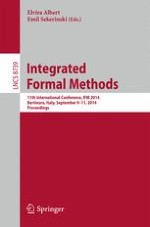2014 | Book
Integrated Formal Methods
11th International Conference, IFM 2014, Bertinoro, Italy, September 9-11, 2014, Proceedings
Editors: Elvira Albert, Emil Sekerinski
Publisher: Springer International Publishing
Book Series : Lecture Notes in Computer Science
